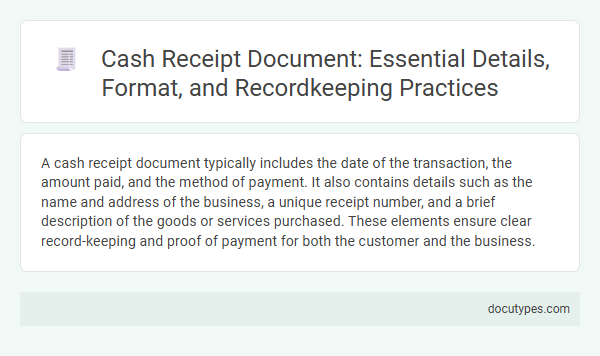A cash receipt document typically includes the date of the transaction, the amount paid, and the method of payment. It also contains details such as the name and address of the business, a unique receipt number, and a brief description of the goods or services purchased. These elements ensure clear record-keeping and proof of payment for both the customer and the business.
Introduction to Cash Receipt Documents
A cash receipt document serves as proof of a financial transaction where cash is exchanged for goods or services. It typically includes essential details that verify the payment and help maintain accurate financial records. Understanding these common elements ensures transparency and accountability in business transactions.
Importance of Cash Receipts in Financial Transactions
A cash receipt document typically includes details such as the date of the transaction, the amount paid, and the payment method. It also lists the items or services purchased along with their prices.
Cash receipts are vital for accurate financial record-keeping and help in tracking income and expenses. They provide proof of payment, which is essential for resolving disputes and managing budgets. Your careful handling of these receipts ensures transparent and accountable financial transactions.
Key Elements of a Cash Receipt
Cash receipts serve as proof of payment and contain essential information for both businesses and customers. These documents help track transactions and maintain accurate financial records.
- Transaction Date - Indicates the exact date when the payment was made to provide a timeline of the purchase.
- Item Description - Lists the products or services purchased to clarify the purpose of the transaction.
- Total Amount Paid - Shows the final payment value, including taxes and discounts, reflecting the amount received.
Key elements on a cash receipt ensure transparency and facilitate efficient record-keeping for all parties involved.
Standard Format of a Cash Receipt Document
| Detail | Description |
|---|---|
| Header | Includes the company or business name, logo, and contact information for identification purposes. |
| Receipt Number | A unique identifier assigned to each transaction for record-keeping and tracking. |
| Date and Time | The exact date and time when the transaction occurred, essential for chronological documentation. |
| Itemized List | Detailed description of purchased items or services including quantities, unit prices, and totals. |
| Subtotal | The sum of item prices before taxes and additional fees are applied. |
| Taxes | Applicable taxes, such as sales tax or VAT, shown separately for clarity. |
| Total Amount | The final payable amount combining subtotal and taxes, prominently displayed. |
| Payment Method | Details of how payment was made, for example, cash, credit card, or digital payment. |
| Cashier or Operator ID | Identification or name of the staff member who processed the transaction. |
| Footer | Optional section with return policies, thank you notes, or additional remarks. |
Essential Information to Include in Cash Receipts
Cash receipts serve as proof of payment and contain essential information to ensure accuracy and transparency. Key details include the date of the transaction, the amount paid, and the method of payment used.
The receipt usually features the name and address of the business issuing it, along with a unique receipt number for record-keeping. Customer details and a brief description of the purchased items or services often appear to clarify what the payment covers.
Best Practices for Creating Cash Receipts
Cash receipts serve as proof of payment and record essential transaction details. Creating clear and detailed cash receipts enhances financial accuracy and accountability.
- Date and Time - Including the exact date and time of the transaction ensures precise record tracking for both parties.
- Itemized List of Goods or Services - Detailed descriptions enable transparency and help resolve any future disputes regarding the purchase.
- Transaction Amount and Payment Method - Clearly stating the total amount paid and specifying the payment method validates the receipt and facilitates easy reconciliation.
Electronic vs. Paper Cash Receipts
Cash receipts typically include essential details such as the date of transaction, payment amount, and method of payment. Both electronic and paper cash receipts display these core elements to ensure accurate record-keeping.
Electronic cash receipts often feature transaction IDs and digital signatures for enhanced verification. Paper cash receipts, on the other hand, may include handwritten notes or stamps that serve as physical proof of purchase.
Legal Requirements for Cash Receipt Documentation
What are the legally required details on a cash receipt document? Cash receipts must include the date of the transaction, the amount paid, and the name of the seller or business. Legal requirements also mandate the inclusion of the buyer's information and a clear description of the goods or services provided.
Recordkeeping and Storage of Cash Receipts
Cash receipts typically include essential details such as the date of the transaction, the amount paid, and the method of payment. Recordkeeping of these documents ensures accurate financial tracking and supports audit processes. Proper storage of cash receipts, whether physical or digital, helps maintain organization and prevents loss or damage over time.
What Are the Common Details Found on a Cash Receipt Document? Infographic

